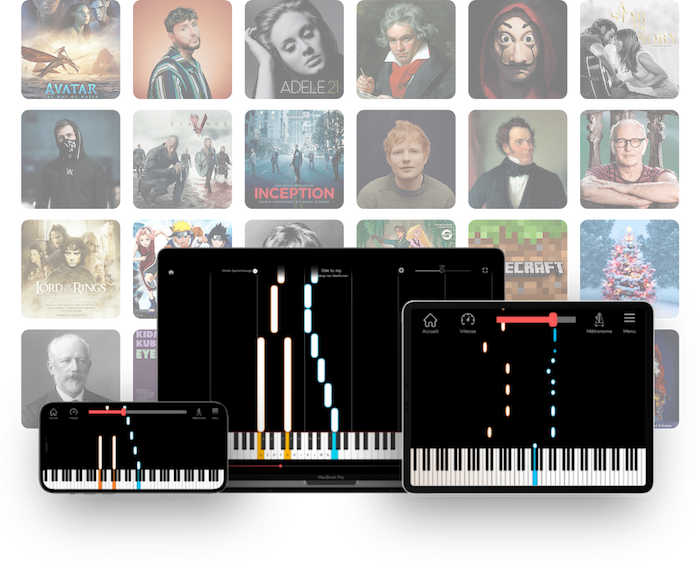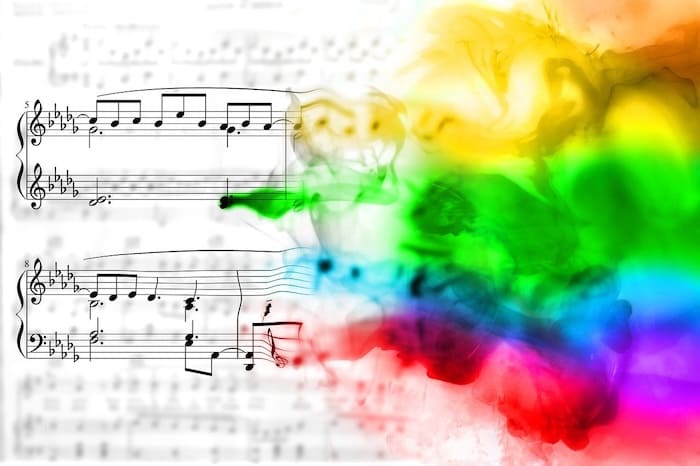
Test your stamina and take on Rush E?! At your own risk…Rush E? Rush means rush and the E corresponds to the note E in the American scale, so we’ll translate it as the mad rush of E!
This is a synthesized piano composition created in 2018 on Synthésia, so the field of possibilities is very wide. The vice, in Rush E, has been pushed very, very far, not without creating fun! This composition starts out simple, classic and accessible. Then, it gradually ventures into more complex and demanding musical territory. As it gains in intensity, you can feel the tension of excitement: a surge of musical frenzy! Rapid chords and dynamic rhythmic patterns create an electrifying atmosphere, challenging even the most experienced pianist.
The main aim of this article is to familiarize you with the piano interpretation of the composition Rush E. We’ll start with the right-hand notes, then those of the left hand, before combining them with both hands. We’ll follow a step-by-step approach that you can adapt at your own pace. Let’s be clear! Our aim is to guide you as far as possible in the execution of this piece… but don’t hesitate to let us know if you manage to play it in its entirety! 😉
Don’t worry, we’ve taken care to simplify Rush E’s version. We’re committed to providing you with the best possible learning method, and that includes offering you the right versions.
A PDF score of the musical composition is provided at the end of the article, so that you can continue to play the notes of Rush E on the piano.
Are you ready to let your hair down on this crazy composition?
Bonus : you can also learn to play this song at your own pace on our interactive piano learning app La Touche Musicale.
Free download: >> >> The guide to learn 10 easy piano pieces.
Learn to play your favorite songs on the piano
The La Touche Musicale learning app offers more than 2,500 songs to play easily on the piano. Connect your piano to your device and learn to play them at your own pace while having fun.
If you’ve already had your first experience with a piano keyboard, you can take the next step if you like!
If you don’t know the basics of piano playing, don’t rush into it! Take the time to look at the diagram below to learn your way around the keyboard. Good piano playing is first and foremost a question of patience.

The name of the notes on a piano keyboard.
Look closely at this picture of a keyboard, showing all the keys on a piano and the notes associated with them: C, D, E, F, G, A, B. Here are some simple steps to help you find your way around:
We can well imagine your eagerness to get started on this piece straight away. However, knowing your way around the keyboard is essential if you are to play the notes of Rush E on the piano with the greatest possible ease.
Now that you’ve got the ability to spot any note on your keyboard, let’s start learning the melody using the right hand.
To do this, we need to identify the first note to be played on the piano with the right hand. For Rush E, the first note is an E.

E is the first note to be played with the right hand for the Rush E piano composition.
You’ve learned to spot the notes on your keyboard and you know the starting note for playing Rush E on the piano. Now you’re ready to play the melody.
We’ll start by pressing the following notes in succession:
E – E – E – E – E – E – E – E – E – E – E – E – E – E – E – E – E – E – E – E – E – E – E – E – E – E – E – E – E – E – E – E – E – E – E – E – E – E – E – E – E – E – E – E – E – E – E – E – E – F – E – D# – E – A – C – D – D – D – D – D – C – B – D – C – C – C – C – C – B – A – C – B – B – B – B – F# – B – G# – E – E – E – E – E – E – E – E – E – E – E – E – E – E – E – E – E – F – E – D# – E – A – C – E – A – C – D – C – B – D – C – B – A – C – B – A – G# – B – A – E – C – A – F – E – D – C – B – A – G# – B – A – E – E – E – E – E – E – E – E – E – E – E – E – E – E – E – E – E – E – E – E – E – F – E – D# – E – A – C – D – D – D – D – D – C – B – D – C – C – C – C – C – B – A – C – B – B – B – B – F# – B – G# – E – E – E – E – E – E – E – E – E – E – E – E – E – E – E – E – E – F – E – D# – E – A – C – E – A – C – D – C – B – D – C – B – A – C – B – A – G# – B – A – E – C – A – F – E – D – C – B – A – G# – B – A – D – C# – D – E – F – E – D – F – E – D – C – D – E – C – B – A# – B – C – D – C – B – D – C – A – C – E – A – E – C – A – D – C# – D – E – F – E – D – F – E – D – C – D – E – A – D – F – E – C – D – B – A – E – A – E – E – E – E – E – E – E – E – E – E – E – E – E – E – E – E – E – E – E – E – E – F – E – D# – E – A – C – D – D – D – D – D – C – B – D – C – C – C – C – C – B – A – C – B – B – B – B – F# – B – G# – E – E – E – E – E – E – E – E – E – E – E – E – E – E – E – E – E – F – E – D# – E – A – C – E – A – C – D – C – B – D – C – B – A – C – B – A – G# – B – A – E – C – A – F – E – D – C – B – A – G# – B – A – E – E – E – E – E – E – E – E – E – E – E – E – E – E – E – E – E – E – E – E – E – E – F – E – D# – E – A – C – D – D – D – D – D – C – B – D – C – C – C – C – C – B – A – C – B – B – B – B – F# – B – G# – E – E – E – E – E – E – E – E – E – E – E – E – E – E – E – E – E – F – E – D# – E – A – C – E – A – C – D – C – B – D – C – B – A – C – B – A – G# – B – A – E – C – A – F – E – D – C – B – A – G# – B – A – D – C# – D – E – F – E – D – F – E – D – C – D – E – C – B – A# – B – C – D – C – B – D – C – A – C – E – A – E – C – A – D – C# – D – E – F – E – D – F – E – D – C – D – E – A – D – F – E – C – D – B – A – E – A – E – E – E – E – E – E – E – E – E – E – E – E – E – E – E – E – E – E – E – E – E – F – E – D# – E – A – C – D – D – D – D – D – C – B – D – C – C – C – C – C – B – A – C – B – B – B – B – F# – B – G# – E – E – E – E – E – E – E – E – E – E – E – E – E – E – E – E – E – F – E – D# – E – A – C – E – A – C – D – C – B – D – C – B – A – C – B – A – G# – B – A – E – C – A – F – E – D – C – B – A – G# – B – A – F – F – F – F – F – F – F – F – F – F – F – F – F – F – F – F – F – F – F – F – F – F# – F – E – F – A# – C# – D# – D# – D# – D# – D# – C# – C – D# – C# – C# – C# – C# – C# – C – A# – C# – C – C – C – C – G – C – A – F – F – F – F – F – F – F – F – F – F – F – F – F – F – F – F – F – F# – F – E – F – A# – C# – F – A# – C# – D# – C# – C – D# – C# – C – A# – C# – C – A# – A – C – A# – F – C# – A# – F# – F – D# – C# – C – A# – A – C – A# – D# – C# – C – D# – C# – C – A# – C# – C – A# – A – C – A# – F – C# – A# – F# – F – D# – C# – C – A# – A – C – A#
Once you’ve learned to play all these notes with your right hand at your own pace, you’ll be able to consider the melody part tamed, and let’s not forget that we’re talking about Rush E … the composition you wonder when you’ll crack!
In general, practice repeating each sequence several times before moving on to the next, and so on, until your playing becomes more and more fluid. You’ll feel more and more at ease, and you’ll see that you’ll naturally master the different sequences.
Once you’ve reached this stage, you can concentrate on learning the Rush E accompaniment, to be played on your piano keyboard with your left hand.

Rush E on the piano: the notes of the right hand.
Musical excitement can reach a crescendo! We’re sharing this video tutorial for flexible, fun learning, suitable for all levels. Take your time, and don’t hesitate to move forward in short sequences.
Congratulations, you’ve deftly navigated your way through the Rush E frenzy!
Now let’s move on to the left-hand accompaniment!
La Touche Musicale app waits for you to play the right note with your right hand on your piano before moving on to the next one.
In this section, we’ll look at the notes of the Rush E accompaniment to be played on the piano. The accompaniment is played with the left hand.
Follow the same method as for the right hand, identifying the first note to be played. For Rush E… rest assured, it’s not an E… the accompaniment starts with the note A.

A is the first note to be played on the piano with the left hand for Rush E.'s composition.
Left hand requisitioned, fingers positioned on A, you will then play each note of the Rush E accompaniment in turn:
A – C + E – E – C + E – A – C + E – E – C – A – E – A – E – A – E – E – A – E – G# – E – A – E – B – F# – E – E – A – E – A – E – A – E – A – E – D – C – B – A – E – G# – A – E – A – E – A – E – A – E – A – E – G# – E – A – E – B – F# – E – E – A – E – A – E – A – E – A – E – D – C – B – A – E – G# – A – A – D – A – D – A – A – C – A – C – A – E – B – E – B – C – A – C – E – A – A – D – A – D – A – A – C – A – C – A – B – D – E – C – D – B – A – E – A – E – A – E – A – E – A – E – A – E – G# – E – A – E – E – B – F# – E – E – A – E – A – E – A – E – E – A – E – D – C – B – A – E – G# – A – A – A – C + E – E – C + E – A – C + E – E – C + E – A – C + E – E – C – E – A – C + E – E – C + E – A – C + E – E – C + E – A – C + E – E – C + E – A – C + E – E – C – A – C + E – E – C + E – A – E – A – E – A – E – A – E – G# – E – A – E – B – F# – E – E – A – E – A – E – A – E – E – A – E – D – C – B – A – E – G# – A – A – D – A – D – A – C – A – C – A – E – B – E – B – C – A – C – E – A – A – D – A – D – A – C – A – C – A – B – D – E – C – D – B – A – E – A – E – A – E – A – E – A – E – A – E – G# – E – A – E – B – F# – E – E – A – E – A – E – A – E – E – A – E – D – C – B – A – E – G# – A – A – A# – F – F – A# – F – F – A# – F – A# – F – A – F – A# – F – C – G – F – F – A# – F – A# – F – F – F – A# – F – F – A# – F – D# – C# – C – A# – F – A – A# – A# – D# – C# – C – A# – F – A – A#
If you can play all the notes smoothly, don’t wait! Move on to the next level!
If necessary, take your time practicing. Break the piece down into several sequences, and only move on to the next one if you’ve got it right!

Rush E on the piano: the notes of the left hand.
Below is a video tutorial to help you excel at playing the notes of Rush E’s piano accompaniment.
Left hand ready? Enjoy the note race!
The La Touche Musicale app waits for you to play the correct note with your left hand on your piano before moving on to the next.
Magnificent! You tamed the frenzy of Rush E’s melody and accompaniment, each in their own way. That’s already an excellent performance!
Now we’re going to turn up the pressure (inherent to the piece, of course – playing the piano isn’t a source of stress, it’s a pleasure). You’re going to play the notes of Rush E on the piano, using both hands simultaneously.
Don’t be afraid! Our tips are just below, and our tutorial is here to guide you!
Playing with both hands is the ultimate challenge for any beginner pianist. So stay cool and remember that it’s perfectly normal to have difficulties at first.
Don’t question your skills on the first try. You probably don’t remember it, but you didn’t get it right the first time – it took many tries and a few falls.
Start small. Don’t set your goals too high right from the start. If you try to master the piece with both hands in record time, you’ll be sorely disappointed. Learning should be synonymous with pleasure.
The main advice is the same as before: divide the piece into short sequences of a few seconds (5 to 10 seconds, no more).
First practice playing only the melody for these few seconds, then concentrate on the accompaniment. Once you feel comfortable with each hand individually, try playing both together.
As soon as you’ve mastered one sequence with both hands, move on to the next. Proceed in this way, sequence by sequence, until you reach the last note of the piece.
We remind you that this piece has energized a whole host of pianists. Think of Rush E as a game, and consider that if this is your first piano piece, it may not be the best one to learn (although it has been simplified).
Just enjoy it and go for it!
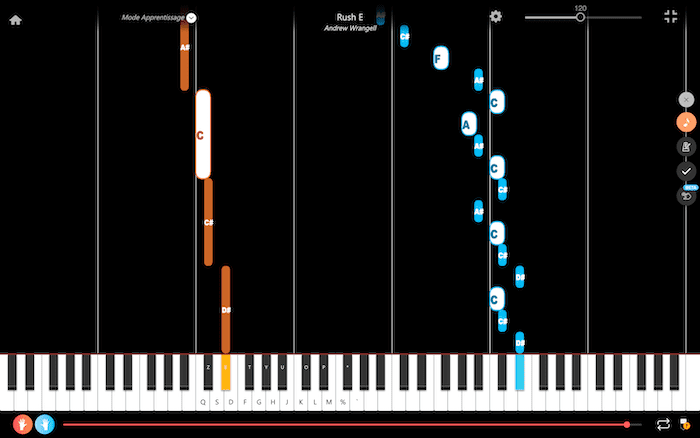
Rush E on the piano: the notes of both hands.
Ready to play the notes of Rush E with both hands on the piano?
Pay attention to the different tempos and concentrate on coordinating the notes between the two hands.
Sometimes certain notes need to be played simultaneously, while others need to be played one after the other.
Don’t hesitate to pause the video when the notes arrive on the virtual keyboard, so that you can position your fingers to play the right notes at the right time. If you get confused, go back to the basics: right hand, then left, then both.
It’s true that it’s a bit constraining to keep pressing the video’s play/stop button. Please note that these videos are taken from our La Touche Musicale app.
Our app also offers a learning mode. The main feature of this mode is that the app waits for you to play the right notes before continuing.
It also lets you display the notes in Latin (Do, Ré, etc.) or Anglo-Saxon (C, D, etc.) versions, and you can even choose not to indicate them to spice up the exercise 🙂
With these tips in mind, let’s get on with the final phase!
Ajoutez votre titre ici
The La Touche Musicale app waits for you to play the right notes with both hands on your piano before moving on to the next.
So how do you feel after this E? race? Did you arrive unscathed? 🙂
We congratulate you on having succeeded in playing the notes of Rush E on the piano with both hands! And we’re sure your curiosity will inspire you to explore the art of piano playing even further. For your information, users of our La Touche Musicale app can choose the level of difficulty with which they wish to play, and our repertoire of songs has been designed to offer an unrivalled experience for everyone.
Below are some tutorials that may be of interest to you:
You’ve come a long way! You’ve learned to find your way around the keyboard, to know the notes of Rush E and, above all, to know how to play them on the piano, coordinating your two hands. You should be very proud of yourself!
Here’s a link to download the score of Rush E in PDF format. You can play this piece whenever you like!
We’re delighted to have accompanied you during this musical interlude, and wish you all the best for the future!
Share the article on:
La Touche Musicale offers powerful AI apps to help you learn, play, and transcribe music effortlessly. Discover them below.
Ideal for: solo piano

Transcribe your piano pieces to sheet music with unrivalled precision.
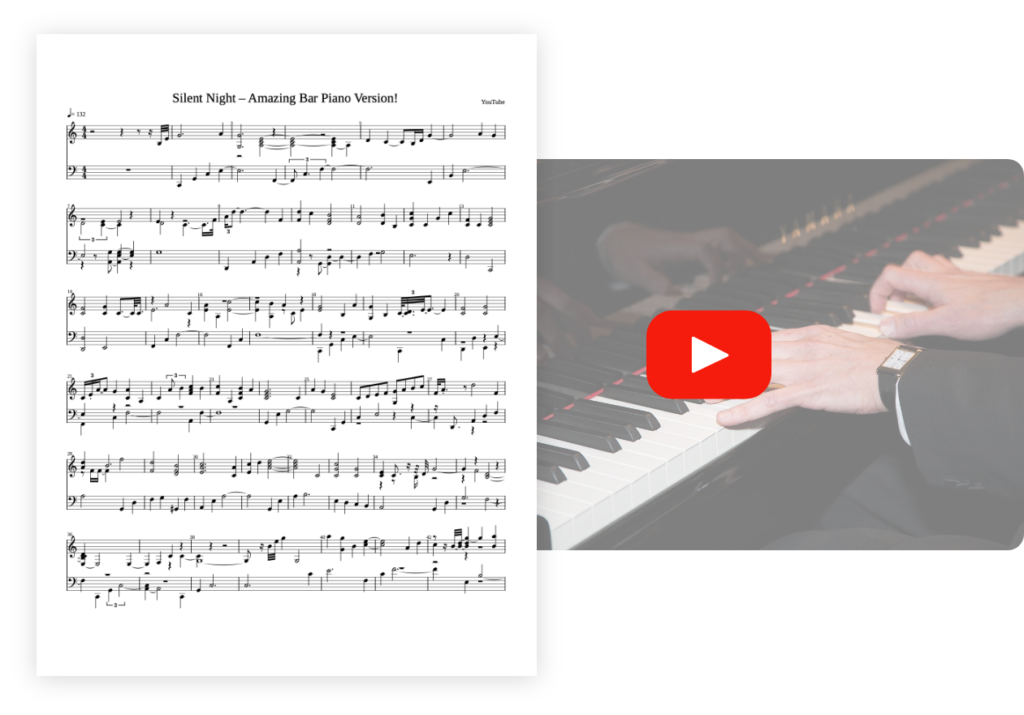
Ideal for: solo guitar

Transcribe your guitar tunes into tablature with unrivalled precision.
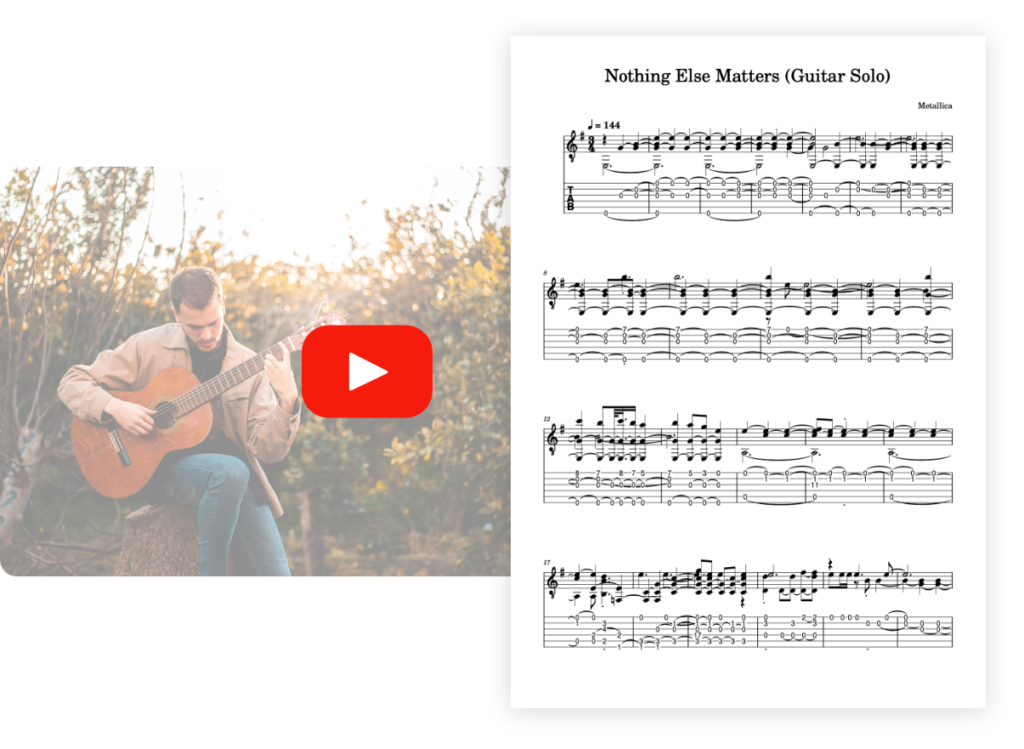
Ideal for: solo vocals

Transcribe your vocal recordings into sheet music with unrivalled precision.
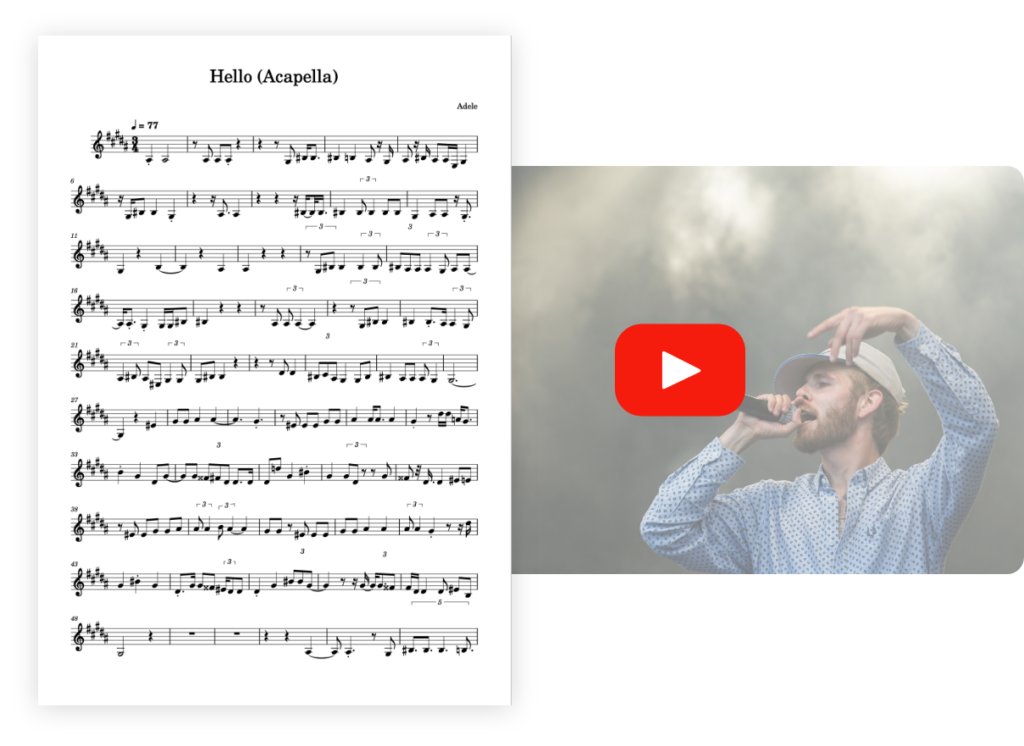
Ideal for: multi-instruments

Transcribe your multi-instrument tracks into sheet music with unrivalled precision.
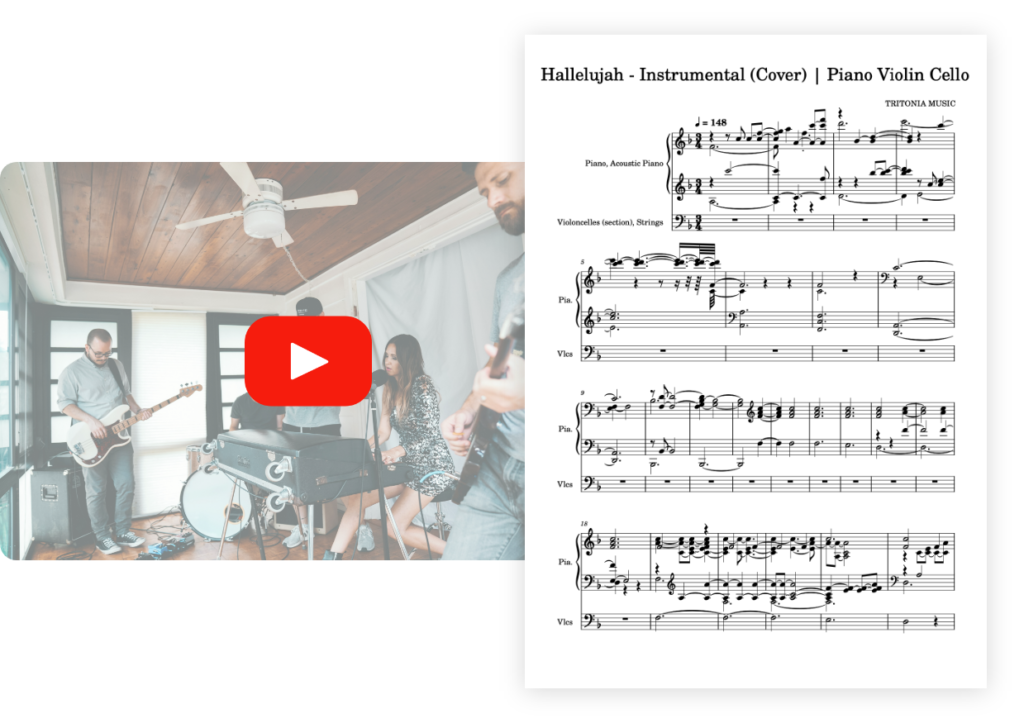
Ideal for: solo drums

Transcribe your drum tracks into sheet music with unrivalled precision.

Ideal for: solo violin

Transcribe your violin pieces into sheet music with unrivalled precision.
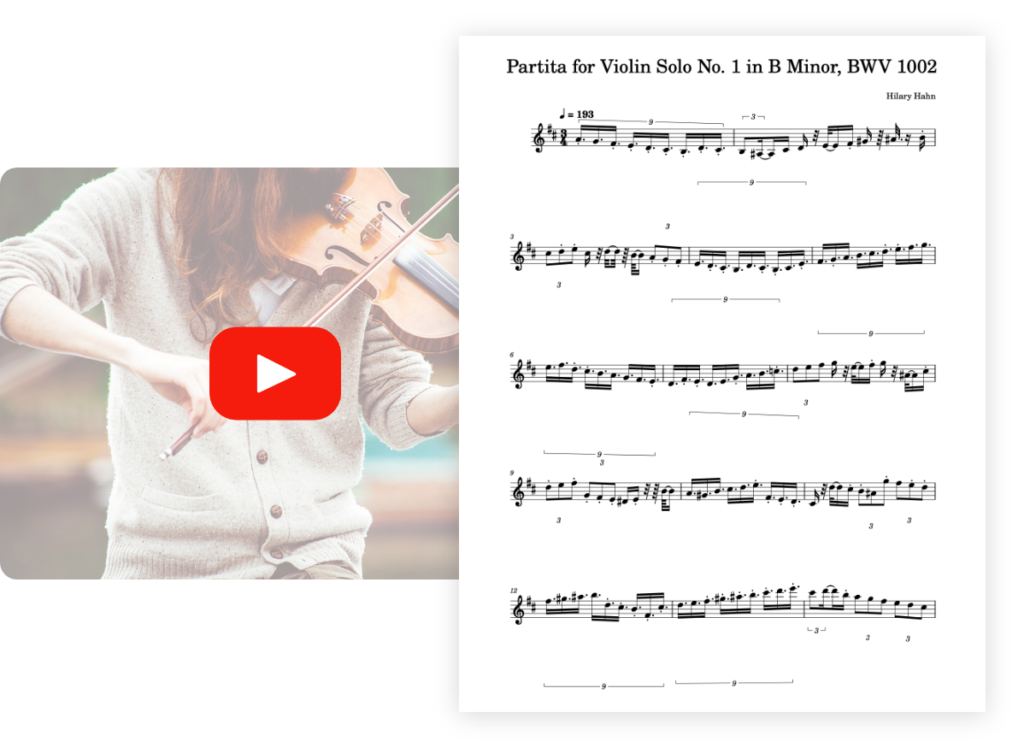
Optimized for: solo saxophone 🎷

Transcribe your saxophone pieces into sheet music with unrivaled precision.

Optimized for : solo flute 🪈

Transcribe your flute pieces into sheet music with unrivaled precision.
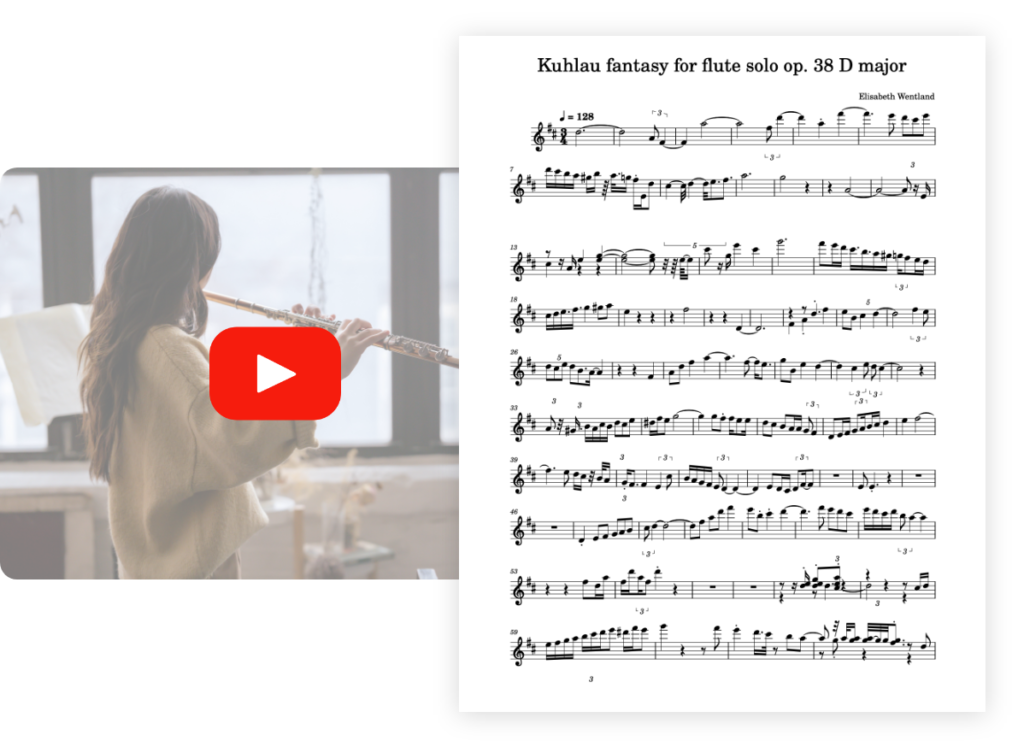
Optimized for : solo bass 🪕

Transcribe your bass pieces into sheet music with unrivaled precision.
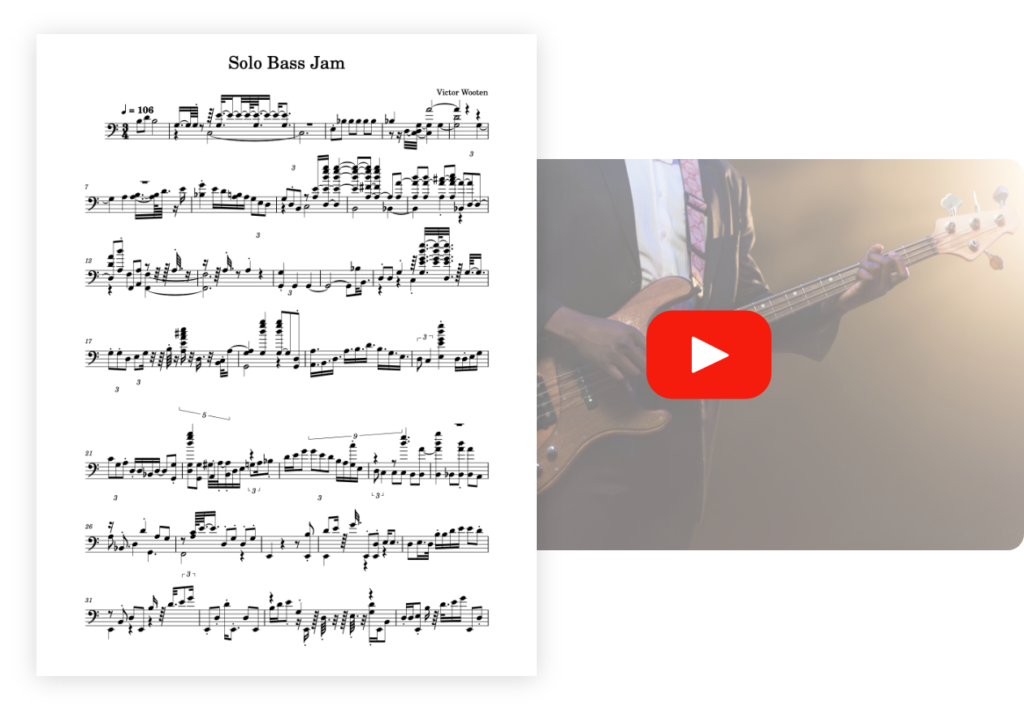
PianoGo lets you learn to play over 3,000 songs easily on the piano.
